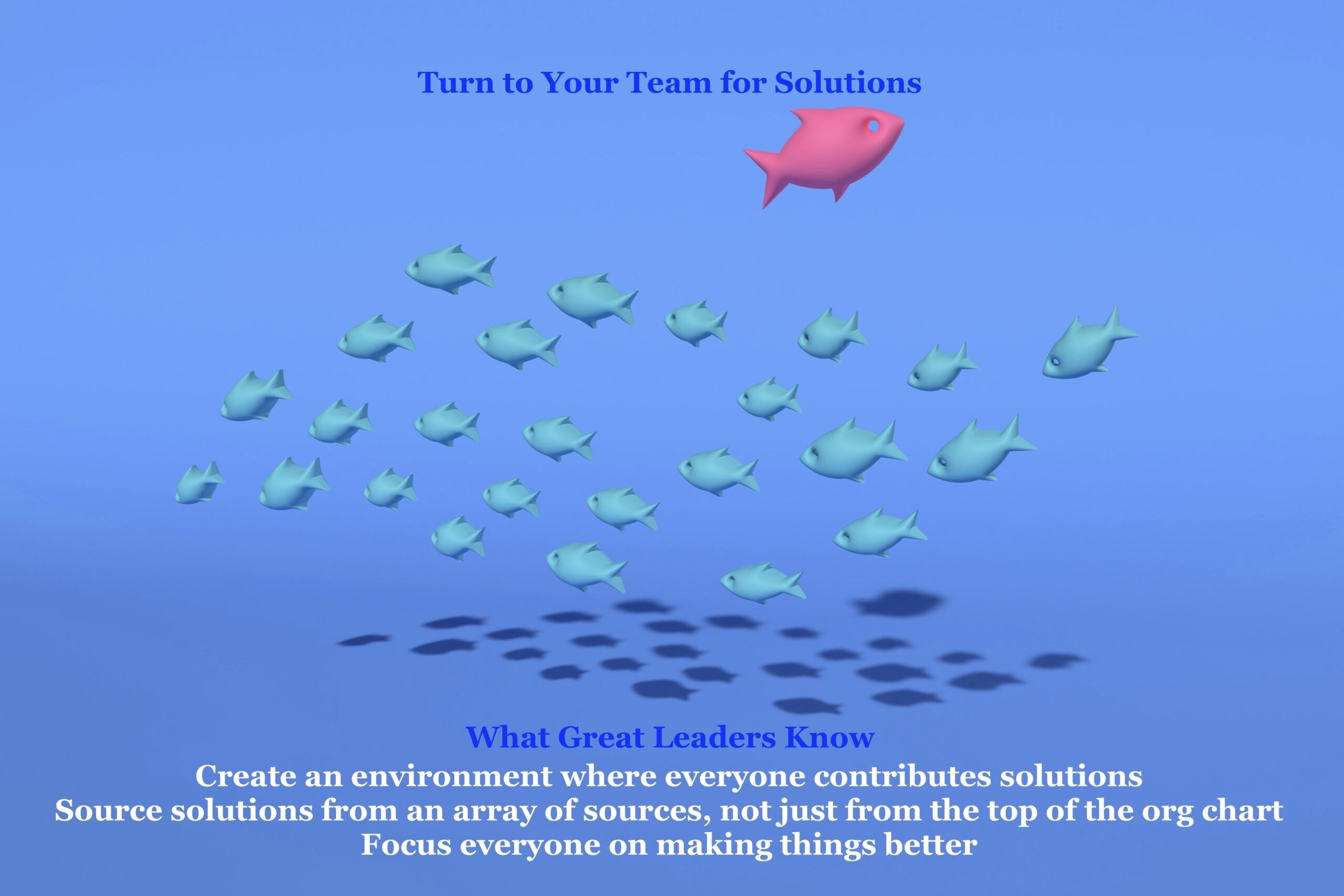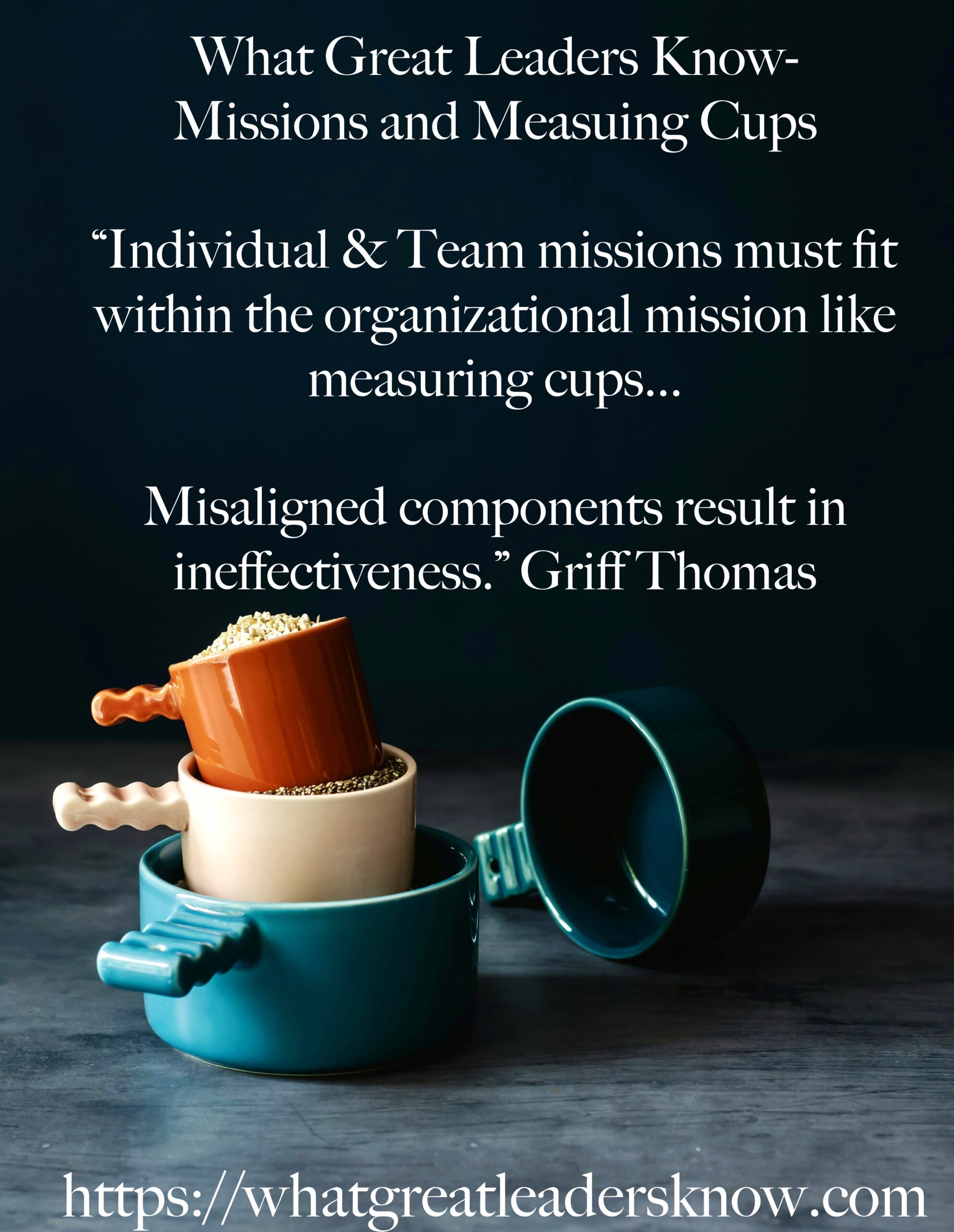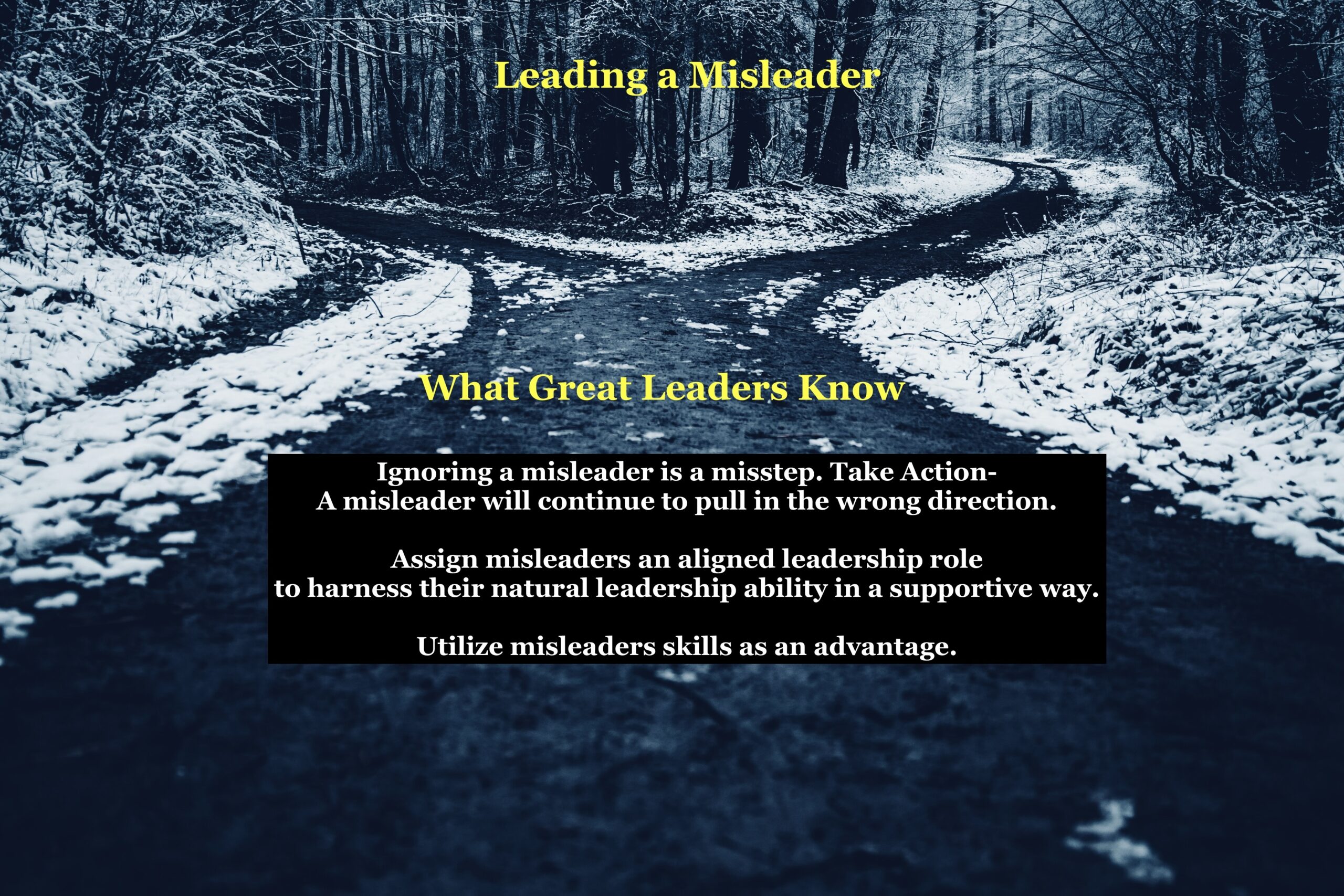Your cart is currently empty!
Tag: Leadership

Turn to Your Team for Solutions
Many minds are better than one. Turn to Your Team for Solutions.
Have you ever worked at a job where every decision had to be made by the boss rather than turning to the team for solutions? Asking your team for solutions is a model for growth while single approval control is a misstep. Following the traditional model of business means yielding to the more senior leader as the expert in all circumstances. To be fair, nobody can be an expert at everything or should be expected to be.
Great Leaders know solutions, ideas, innovations come from an array of sources and their role is not to be the one and only solution provider, but the person who creates an environment where everyone has value and is depended upon to contribute to solving problems, innovation, growth.
The obstacle to including team members in decision making is the leader’s need to control. It may seem like the right thing to do is to defer to the boss, but this presents individuals from learning how to make decisions and grow.
When I learned to give problems back to my team, they generated amazing solutions.
Since they were hitting the roadblock day after day, they had a perspective I did not. I made it my goal to engage the team in problem solving. When they would ask me what to do, I asked them what they thought. If they provided a workable solution, I would let them introduce it and give them credit- “We’re going to follow Amy’s plan today.” As you can imagine, Amy’s stock rose among her peers and everyone on the team was motivated to provide the next solution. When other teams spent time gossiping and tuning out, mine were thinking about how can we make things better. Not everyone can offer a workable solution, but that’s not important, engaging them is important.
I remember asking my front line team how we can reduce supply costs. They knew exactly what needed to happen and we reduced supply costs by 20%. They were excited to watch our progress! I was too!
By turning to your team for solutions, employee engagement, retention rates and operational performance results will all improve, leaving the controllers in your wake.
What Great Leaders Know
Create an environment where everyone contributes solutions
Source solutions from an array of sources, not just from the top of the org chart
Focus everyone on making things better
Links
https://whatgreatleadersknow.com/
https://hbr.org/2023/03/how-to-equip-your-team-to-problem-solve-without-you

Teach, Don’t Do: A Leadership Mindset
Teach, Don’t Do Understanding what great leaders know can vastly improve your leadership skills.
The most important role a leader plays is teacher. Teach, Don’t Do is my shorthand for “Give someone a fish and you feed them for a day. Teach someone to fish and you feed them for a lifetime”, generally attributed to Chinese philosopher Lao Tzu. Successful leadership comes from knowing what great leaders know and applying it effectively.
In many cases, it is faster and easier to just fix the problem, but then, how will anyone else ever learn? Suppose, I never explained to my kids what to do when the smoke alarm starts beeping. All I ever did was say, I’ll take care of it. I’m locked in as the official smoke detector fixer. Will my kids grow up and move away and still call me when the smoke alarm battery needs replacing? Now, I am driving 4 hours in the middle of the night (smoke detector batteries always run low in the middle of the night don’t they) when I could have taught them long ago and they would have taken care of it and I would still be sleeping.
The more people who know how to do something, the more the team benefits. If only one of member of the Women’s Olympic Team has mastered the bar, the team is in trouble if that person is injured. If only one person knows how to submit payroll, when that person takes a vacation, there’s going to be a problem. Great leaders know this and ensure every team member is prepared.
Those mentors I have respected most were all excellent teachers who took stock of my abilities and challenged me move beyond them, seeing something that wasn’t yet there and understanding it could be. Investing time with me to help me grow. Wanting what was best- for me! When I grew, I applied what I had leaned, I became a stronger leader. Research shows 74% of adults consider themselves lifelong learners! Teaching them is an investment, rather than a waste of time.
My point is not that a leader should never do anything directly. Great leaders know that teaching the team is everything!
Great Leaders Know- Teach, Don’t Do
The most important role a leader plays is teacher. This is a foundational principle that great leaders know.
Make Teach, Don’t Do your mantra.
The more people know how to do something, the more the team benefits. As any great leader knows, this is vital for team success.
Links
https://whatgreatleadersknow.com
https://www.pewresearch.org/internet/2016/03/22/lifelong-learning-and-technology

Mastering the Art of Hiring: Great Leaders Know Whom To Hire
Mastering the art of hiring is essential for any great leader to ensure long-term success. Indeed, mastering the process can make all the difference.
Everyone is looking for the right team members, but few actually hire them and fewer still retain them, yet the most important decision Great Leaders make is hiring the right person. But how to do it? Mastering the art of hiring requires dedication and strategy.
Hire for mission alignment and natural ability then teach skills. Remember, mastering the art of hiring involves focusing on the right attributes.
Focus Interviews on understanding the candidate’s personal mission- why the candidate did what they did matters even more than what they did, but most interviews focus on what. Understanding the why helps determine mission alignment between the candidate and the organization. Employers want to hire people who have the same mission as their organization. Employees want to work for organizations that align with their personal mission. Great Leaders Know Whom To Hire, and aligning missions is the initial step.
Great Leaders Know there is no substitute for talent.
Hiring is the most important opportunity any leader has. Retention is the second. Yet, many sourcing, hiring, onboarding, and development processes do not receive sufficient focus or resources. Great Leaders Know Whom To Hire and how crucial it is to retain those hires. By mastering the art of hiring, they secure their organization’s future.
Personality traits like imagination, organization, and math skills are with us since birth, although they can be developed or stunted based on our life experiences. Many skills, like following a set instructions or processes, can be taught.
Great Leaders highly value experience because it demonstrates a continued pattern of success and the ability to learn. It demonstrates what someone has done and what they might be able to do. However, experience is not a substitute for ability, and great leaders know they must balance both when hiring.
Every organization is a tapestry of the aligned and mis-aligned, an array of natural abilities, a wealth of experience, and fresh eyes, and a spectrum of learning styles. Great Leaders orchestrate the performance of individuals and the team, knowing whom to hire to maintain a harmonious balance. Mastering the art of hiring ensures this balance is optimal.
Great Leaders Know
Hire for mission alignment and natural ability then teach skills
There is no substitution for talent
Hiring is the most important opportunity any leader has
Links
https://www.yardstick.team/interview-questions/mission-orientation

Missions & Measuring Cups
We have a set of nesting measuring cups in our kitchen, the smaller cups fitting inside the larger cups. It is an effective way to organize this useful tool. Measuring cups remind me of how the mission of individuals who work for an organization must be concentric, nested, fitting inside one another.
For example, the 1/4 cup represents the organizational mission, which fits into the 1/3 cup which which represents the mission of the senior leadership team, which fits into the 1/2 cup representing the middle managers, which fits into the 1 cup, which represents the mission of the front line team members.
If your measuring cups have been pieced together, they may not fit, you may have duplicate or be missing cups, they may be inefficient to use. Similarly, the organization will be less effective when missions are not aligned, much like misaligned Missions and Measuring Cups.
What Great Leaders Know
Missions and Measuring Cups are concentric
Individuals and Teams have missions that align with the organizational mission
Misaligned or mismatched components will result in ineffectiveness for the organization
Links

Lead With Confidence
Shaquille O’Neal never has to tell anyone he is really tall (7 feet 1 inch!). Why? Because he knows he is and we can see that he is in person or on TV. What would it be like if he walked around telling everyone he was really tall? Would you be suspicious?
Gold Medalist gymnast Simone Biles doesn’t spend her time telling everyone she meets that she is a champion gymnast. To lead with confidence, she doesn’t need to boast. Why? Because she knows she is and we have seen her in the Olympics. What if you met Simone and she greeted you with a list of her accomplishments? Would it inspire confidence or concern?
Great leaders know they don’t have to tell people they are the boss because they lead with confidence and act accordingly. Their team members understand from observing and interacting that the leader is the leader. Managers who continually stand behind their title have an important lesson to learn- using a title to provide leverage reduces effectiveness.
When a manager regularly says “You have to do what I say because I’m the manager” it is because THEY don’t believe in themselves. Leading with confidence is key because if they don’t believe, the team won’t either. The team still needs to do what the manager says, however, a leader without confidence will be seen as ineffective. This type of behavior will earn compliance- the lowest level of performance.
What Great Leaders Know
- Have confidence in yourself
- There is no need to proclaim you are the leader when you know you are and lead with confidence
- Using a title as leverage weakens the perception of the leader
Photo by Brooke Lark on Unsplash
Links

Great Leaders Show Great Character
Character is about what you do. Great leaders show great character in their actions and decisions, proving true leadership goes beyond words.
Great Leaders Know it is what they do, not what they say that matters. Exceptional leadership is not about putting on a show, about fooling people into believing something you know is not true. Leadership requires authenticity. If the idea of being your authentic self concerns you, let someone else lead. Leaders with character always generate dedicated followers. Showing great character is essential for leaders, illustrating that great character is shown by great leaders, who always generate dedicated followers. Great Leaders, with great character, gain dedicated followers. Great leaders, who exhibit remarkable character, gain dedicated followers.
People remember their relationships with leaders. What would you want people to say about you? Great leaders think about their legacy and the character they leave behind. This consideration of legacy is crucial because great leaders consistently exhibit great character in their actions.
Great Leaders Show Great Character
- Your character is the only thing you own, and it shows in great leaders, illustrating their integrity.
- Character is about what you do, and great leaders exhibit this, highlighting how actions speak louder than words.
- Great leaders think about the legacy of character they leave behind, proving that great leaders always show great character.
Links
https://whatgreatleadersknow.com
https://dictionary.cambridge.org/us/dictionary/english/seeing-is-believing#google_vignette

Long work to do list? Start with One
What Great Leaders Know- Start With One
Facing a long work to-do list? Start with one task to make progress and stay productive. When dealing with a long work to-do list, start with one task at a time.
From 50 things to do to 1
My wife taught me a very valuable lesson to help me in a time of great frustration. I had started a new job and inherited many, many operational issues. Directing 115 front line employees alone was a ridiculous situation and working long hours didn’t help. While I worked on finding another job, I made a list of important things to do. I stopped writing when I reached 50! Frustrated mounted as day after day, I attacked my list, but never made any progress. Amy convinced me to take a different approach- start with one thing from the long work to-do list and when you can get one thing done, expand your list to two and so on.
A long work to-do list can be overwhelming; start with one task at a time to manage stress effectively. I went back to work the next day fixing my 1 issue- payroll. Having improved the payroll process, I moved on and attacked the work schedule. The other things I simply let go until I could get to them, which was hard, but necessary.
Take the Pressure Off
Sticking with the 1 thing approach lifted the weight of the world from my shoulders and I enjoyed my job again because I was doing my best and I could only do what I could do in that circumstance. What I did not expect was our team performing better. But fixing my most important issue was fixing everyone’s most important issue. Everyone benefitted.
Facing overwhelming challenges, like trying to manage 115 employees alone, all we can do is our best. So, act accordingly. Thanks Amy!
What Great Leaders Know- Start with One
Managing a long work to-do list? Start with one priority first.
When we try to do too much we accomplish nothing
Prioritize your actions
Take advice from the wise people you know
Links
https://whatgreatleadersknow.com
https://www.liquidplanner.com/blog/how-to-prioritize-work-when-everythings-1/

Mastering Leadership: Letting go without losing control
What Great Leaders Know- Southern Fried Rock and Micromanaging
I love music. One of my favorite lyrics appears in the song Hold On Loosely written by James Peterik, Jeff Carllisi, and Richard Donald Barnes for the band 38 Special. There is an unexpected leadership message in, of all places, Southern Fried Rock music. When learning to lead without micromanaging, we can take inspiration from different sources. Letting go without losing control, a lesson from an unexpected source.
“Just hold on loosely but don’t let go”
So much meaning from 8 words. For me, they describe being in a healthy relationship. A healthy relationship is crucial in leadership and avoids the pitfalls of micromanaging. By learning to lead without micromanaging, leaders build solid and trustworthy relationships. Letting go without losing control becomes essential.
Trust, commitment, communication, and boundaries
Great Leaders know healthy relationships are based on trust, commitment, communication, and boundaries. Strong relationships are formed in the forge, which is to say, time has been spent strengthening them through the trial. Great Leaders remain committed to their team members who understand they won’t let go at the first sign of trouble or even the second. Mastering the art of letting go without losing control is key.
Micromanaging is toxic
Great Leaders know micromanaging is neither a healthy nor a pleasant experience. Many managers rely on micromanaging regularly. Faced with a challenge, they return to their default setting, if you want something done right… but this will not work and drives a wedge into the relationship. Micromanaging or over-managing is neither sustainable nor beneficial for the giver or the receiver. Learning to lead without micromanaging is essential to building trust, a two-way street that strengthens the relationship. Great Leaders hold fast but allow for movement. Impeccable communications permit comfort. Thanks to Southern Fried Rock, leaders can learn to manage better. So, remember the importance of letting go without losing control.
What Great Leaders Know
Life lessons can come from unexpected places. Take Southern Fried Rock, for example, which offers insights into leadership and avoiding micromanaging. Thinking about letting go without losing control can provide deeper interpretations.
Strong relationships are formed in the forge, as discussed in both leadership and Southern Fried Rock music. This also applies to the principle of letting go without losing control.
Remain committed to your team members at all times; This shows great leadership and avoids micromanaging.
Micromanaging is destructive for the giver and receiver where trust, is crucial. Learning to lead without micromanaging encourages a healthier work environment and embodies the essence of letting go without losing control.
Links

Great Leadership- Alignment and Mission
We cannot be fulfilled in our work experience if our personal mission is not aligned with our organization’s mission.
When a vehicle is out of alignment, the tires wear out quickly and unevenly delivering an unpleasant ride. Mis-alignment can also damage the breaks, steering and frame. As more time passes without resolving the issue, the more damage is done, the more costly the fix. This is true for Wheels, Alignment and Mission in a professional context as well.
When I have parted ways with employers it has always been because my personal mission no longer aligned with the organization’s mission. Either my personal mission had evolved or I realized the company no longer stood for what I supported. These moments are clear indicators when the focus on Wheels, Alignment and Mission is absent.
I encourage everyone I work with to sit down and write their personal mission statement so they have a North Star. Next, to write down their employer’s mission statement. Compare them. Do they align? Does working for the employer help them achieve their personal mission? How do the leaders of their employer behave in relation to the mission? Is the mission an afterthought, a slogan? Alignment in Wheels, Alignment and Mission is key.
If your employer’s mission or the way they pursue it, doesn’t align with your personal mission, find an organization that does as soon as you can. You will be much happier and less worn down by the journey. Addressing Wheels, Alignment and Mission can help in finding fulfillment in your career.
What Great Leaders Know
Their personal mission
A personal mission must align with our employer’s mission
Missions with conflicting purposes result in unavoidable strain and waste
Links
https://www.firestonecompleteautocare.com/blog/alignment/is-it-time-for-a-wheel-alignment/
